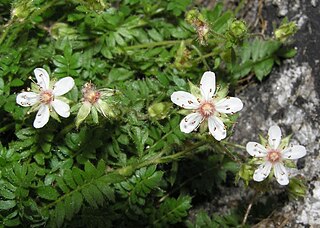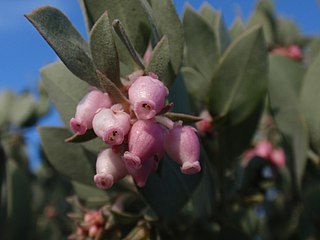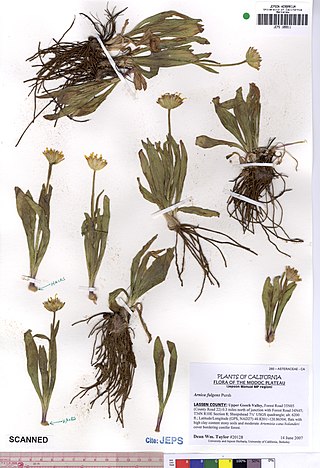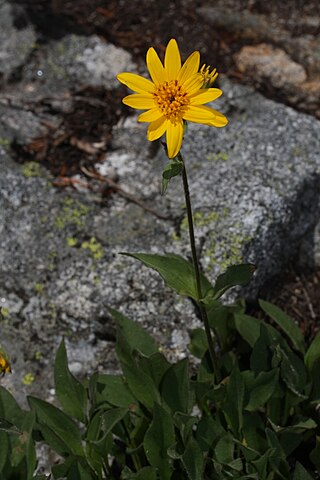
Thunbergia alata, commonly called black-eyed Susan vine, is a herbaceous perennial climbing plant species in the family Acanthaceae. It is native to Eastern Africa, and has been naturalized in other parts of the world.

Bougainvillea glabra, the lesser bougainvillea or paperflower, is the most common species of bougainvillea used for bonsai. The epithet 'glabra' comes from Latin and means "bald".

Vicia hirsuta is a species of flowering plant in the pea and bean family Fabaceae.

Ivesia callida is a rare species of flowering plant, in the rose family, known by the common name Tahquitz mousetail. It is a small perennial herb which forms matted patches of hanging foliage on cliff faces. The leaves are strips of oval-shaped green leaflets. Each leaf is up to 7 centimeters long and has several pairs of hairy, glandular leaflets. The thin, green, hanging stems grow up to 15 centimeters long and bear an inflorescence of several flowers. Each flower has five hairy, pointed sepals and five round to oval white petals. The center of the flower contains twenty stamens with disc-shaped anthers and several pistils.

Acanthomintha lanceolata is a species of flowering plant in the mint family known by the common name Santa Clara thornmint. It is endemic to California, where it is known from several counties surrounding and south of the San Francisco Bay Area. It is an uncommon resident of rocky habitat in coastal and inland mountain ranges.

Arctostaphylos canescens, common name hoary manzanita, is a species of manzanita.

Arnica fulgens is a species of arnica known by the common names foothill arnica and hillside arnica. It is native to western North America, from British Columbia east to Saskatchewan and south as far as Inyo County, California, and McKinley County, New Mexico. It grows in open, grassy areas.

Arnica mollis is a North American species of arnica in the sunflower family, known by the common name soft arnica, or hairy arnica. It is native to Canada and the United States (Alaska and the western mountains as far south as San Bernardino County, California and Rio Arriba County, New Mexico. There are also isolated populations in the White Mountains of Coos County, New Hampshire. The species grows in subalpine mountain habitat such as meadows and streambanks.
Arnica spathulata is a rare North American species of flowering plant in the family Asteraceae, known by the common name Klamath arnica. It is native to the Klamath Mountains of northwestern California and southwestern Oregon. It grows in woodland habitat, almost exclusively on serpentine soils.

Astragalus shevockii is a rare species of milkvetch known by the common names Little Kern milkvetch and Shevock's milkvetch. It is endemic to Tulare County, California, where it grows in the High Sierra, generally on granite-based soils in Jeffrey pine forests.

Balsamorhiza deltoidea is a species of flowering plant in the sunflower tribe of the plant family Asteraceae known by the common name deltoid balsamroot. It is native to western North America from British Columbia to California, where it grows in many types of generally mountainous habitat.
Crepis bakeri is a species of flowering plant in the family Asteraceae known by the common name Baker's hawksbeard. It is native to the western United States where it grows in many types of mountain and plateau habitat. It is found in Oregon, Washington, Idaho, northern California, Nevada, and Utah.
Erigeron multiceps is a species of flowering plant in the family Asteraceae known by the common names Kern River daisy and Kern River fleabane. It is endemic to California, where it is known mostly from the Kern Plateau in the southern High Sierra Nevada of eastern Tulare County. It is a perennial herb growing a hairy stem up to about 20 centimeters tall from a taproot and caudex. The base of the stem is surrounded by oblong leaves 2 to 5 centimeters long, and there are some smaller leaves along the length of the stem. The inflorescence produces hairy, glandular flower heads filled with yellow disc florets and a fringe of up to 125 thin, flat white to purple-tinged ray florets. The fruit is an achene with a pappus of bristles.
Orthocarpus pachystachyus is a rare species of flowering plant in the broomrape family known by the common names Shasta owl's-clover and Shasta orthocarpus. It is endemic to central Siskiyou County, California, where it is so rarely seen it was thought to be extinct until 1996, when eight individuals were located. The plant grows in an isolated wilderness but since it apparently only occurs on one single hillside it is considered very vulnerable to extinction.

Perityle inyoensis, known by the common names Inyo rockdaisy and Inyo laphamia, is a rare species of flowering plant in the aster family.
Silene aperta is a rare species of flowering plant in the family Caryophyllaceae known by the common names naked catchfly and Tulare campion. It is endemic to Tulare County, California, where it is known only from the coniferous forests of the High Sierra Nevada. It is a perennial herb growing from a woody, branching caudex sending up several erect stems up to about 60 centimeters tall. The lower leaves are linear in shape, up to 12 centimeters long but less than one wide. Leaves higher on the stem are smaller. The flower has a hairy, tubular calyx of fused sepals with ten veins. The calyx is open at the top, revealing five white or yellow-green petals each 1 to 2 centimeters long.
Tetradymia tetrameres is a species of flowering plant in the aster family known by the common name fourpart horsebrush and dune horsebrush. It is native to the Great Basin, where it occurs in western Nevada and just over the border in Mono County, California. It is a plant of dry scrub and sand dunes. It is a bushy, woolly shrub with many erect, spineless branches. It is the largest of the horsebrushes, growing up to two meters in height. The soft, woolly leaves are narrow and threadlike, growing up to 4 centimeters long. Shorter leaves occur in clusters around the primary leaves. The inflorescence bears 4 to 6 flower heads which are each enveloped in four or five woolly phyllaries. Each head contains up to four or five light yellow flowers each around a centimeter long. The fruit is a hairy achene which may be up to a centimeter long, including its pappus of long bristles.

Veronica copelandii is a rare species of flowering plant in the plantain family known by the common name Copeland's speedwell.

Agnorhiza ovata is a species of flowering plant known by the common name southern mule's ears. It is native to the mountains and foothills of southern California and Baja California, occurring the Coast Ranges and Sierra Nevada foothills in Tulare, Kern, Ventura, Los Angeles, Orange, Riverside, and San Diego counties in California, with additional populations in the Peninsular Ranges south of the international border.
Cryptantha incana is a rare species of flowering plant in the borage family known by the common name Tulare cryptantha. It is endemic to California in the United States, where it occurs in the forests and woodlands of the southern Sierra Nevada. It is a poorly known species with three occurrences based on three historical collections. It was collected in Tulare County in 1904 and 1941 and once in Inyo County in 1989.














